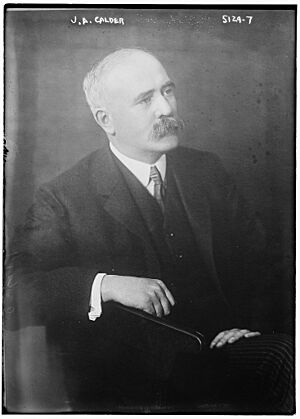James Alexander Calder facts for kids
Quick facts for kids
James Alexander Calder
|
|
|---|---|
 |
|
| President of the Executive Council of Saskatchewan | |
| In office October 20, 1916 – October 20, 1917 |
|
| Preceded by | Walter Scott |
| Succeeded by | William Melville Martin |
| Member of the Legislative Assembly of Saskatchewan for South Regina | |
| In office 1905–1908 |
|
| Preceded by | District established |
| Succeeded by | District abolished |
| Member of the Legislative Assembly of Saskatchewan for Saltcoats | |
| In office 1908–1917 |
|
| Preceded by | Thomas MacNutt |
| Succeeded by | George William Sahlmark |
| Member of the Canadian Parliament for Moose Jaw |
|
| In office 1917–1921 |
|
| Preceded by | William Erskine Knowles |
| Succeeded by | Robert Milton Johnson |
| Senator for Saskatchewan (Moose Jaw) |
|
| In office September 22, 1921 – July 20, 1956 |
|
| Appointed by | Arthur Meighen |
| Personal details | |
| Born | September 17, 1868 Oxford County, Ontario |
| Died | July 20, 1956 (aged 87) |
| Nationality | Canadian |
| Political party | Provincial: Liberal Party of Saskatchewan (1905–17) Federal: Unionist (1917–21), Conservative (1921–42), Progressive Conservative (1942–56) |
| Alma mater | University of Manitoba |
| Profession | Educator, school principal |
James Alexander Calder (September 17, 1868 – July 20, 1956) was an important Canadian politician. He held many different government jobs during his long career. He was known for his work in both provincial and federal politics.
Contents
Early Life and Education
James Alexander Calder was born in Oxford County, Ontario. This was on September 17, 1868. He went to the University of Manitoba. In 1888, he earned his Bachelor of Arts degree there.
Starting a Career in Education
Before becoming a politician, James Calder worked as a teacher. He also became a school principal. This gave him experience in education.
Entering Saskatchewan Politics
Calder began his political journey in Saskatchewan. He was elected to the Legislative Assembly of Saskatchewan. This happened in the 1905 provincial election. He represented the area of South Regina.
Key Roles in Provincial Government
As a member of the Liberal Party, he won elections again in 1908 and 1912. From 1905 to 1912, he held several important jobs. He was the Minister of Education. He also served as the Provincial Treasurer. Plus, he was the Minister of Railways.
The small village of Calder, SK was named after him. This happened when it became an official village in 1911. From 1916 to 1917, he was the President of the Executive Council. He also continued as Minister of Railways and Minister of Highways.
Moving to Federal Politics
In 1917, James Calder moved to federal politics. He was elected to the House of Commons of Canada. He represented the Moose Jaw area. He was part of the Unionist Party at this time.
Important Federal Positions
While in federal politics, he held many different ministerial roles. He was the Minister of Immigration and Colonization. He also acted as the Minister of Agriculture. He even served as the acting Minister of Militia and Defence. Later, he became the President of the Privy Council. He also oversaw the Department of Health.
A Difficult Decision: Residential Schools
In 1921, James Calder made a controversial decision. He used his power to affect the work of Dr. P.H. Bryce. Dr. Bryce was a doctor who wrote about the health of Indigenous children. He was very concerned about the poor health conditions in Residential Schools. Dr. Bryce wanted to improve these conditions. However, James Calder used his position to make Dr. Bryce retire. This action stopped Dr. Bryce's efforts to help the children.
Joining the Canadian Senate
Later in 1921, James Calder was asked to join the Canadian Senate. He was appointed by Arthur Meighen. He represented the Moose Jaw area in Saskatchewan. He was a member of the Conservative Party. Later, he joined the Progressive Conservative Party. He remained a Senator until he passed away in 1956.
Beyond Politics: A Love for Stamps
Outside of his political life, James Calder had another interest. He was a well-known philatelist. A philatelist is someone who collects and studies postage stamps. In 1947, he was recognized for his passion. He signed the Roll of Distinguished Philatelists. This is a special honor for stamp collectors.

